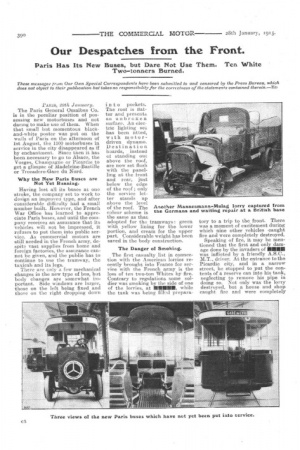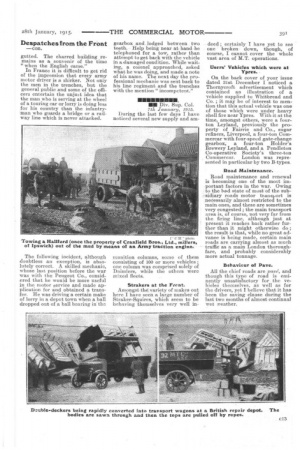Our Despatches from the Front.
Page 2

Page 3

If you've noticed an error in this article please click here to report it so we can fix it.
Paris Has Its New Buses, but Dare Not Use Them. Ten White Two-tonners Burned.
These message:. trout Our Own Special Correspondents have been submitted to and censored by ihe Press Bureau, which does not object to their pubiLealcon but takes no responsibility for the correctness of the statements contained therein.—ED
PARIS, 20th January.
The Paris General Omnibus Co. is in the peculiar position of possessing new motorbuses and not daring to make use of them. When that small but momentous blackand-white poster was put on the walls of Paris on the afternoon of let August, the 1100 motorbuses in service in the city disappeared as if by enchantment.. Since then it has been necessary to go to Alsace, the Vosges, Champagne or Picarde to get a glimpse of Madeleine-Bastille or Trocadero-Gare du Nord.
Why the New Paris Buses are Not Yet Running.
Having lost all its buses at one stroke, the company set to work to design an improved type, and after considerable diffi3ulty had a small number built. However, the French War Office has learned to appreciate Paris buses, and until the company receives an assurance that its vehicles will not he impressed, it refuses to put them into public service. As commercial motors are still needed in the French army, despite vast supplies from home and foreign factories, the assurance cannot be given, and the public has to continue to use the tramway, the taxicab and its legs.
There are only a few mechanical changes in the new type of bus, but body changes are somewhat important. Side windows are larger, those on the left being fixed and those on the right dropping down into pockets. The root is batter and presents an unbroken surface. An electric lighting sez, has been ntted, with motordriven dynamo. Destination boards, instead of standing out above the roof, are now set flush with the panelling at the front and rear, just below the edge of the roof ; only the service letter stands up above the level of the roof. The colour scheme is the same as that adopted for the tramways : green With. yellow lining for the lower portion, and cream for the upper part. Considerable weight has been saved in the body construction.
The Danger of Smoking.
The first casualty list in connection with the American lorries recently brought into France for service with the French army is the loss of ten two-ton Whites by fire. Contrary to regulations some soldier was smoking by the side of one of the lorries. at MMU, while the tank was being B.11d prepara
tory to a trip to the front. There was a moment of excitement during which nine other vehicles -caught fire and were completely destroyed.
Speaking of fire, it may be mentioned that the first and only damage dorm by the invaders of NENE was inflicted by a friendly A.S.C., M.T., driver. At the entrance to the Picardie city, and in a narrow street, he stopped to put the contents of a reserve can into his tank, neglecting to remove his pipe in doing so. Not only was the lorry destroyed, but a house and shop caught fire and were completely
gutted. The charred building remains as a souvenir of the time "when the English came."
In France it is difficult to get rid of the impression that every army motor driver is a shirker. Not only the men in the trenches, but the general public and some of the officers entertain the unjust idea that the man who is serving at the wheel of a touring car or lorry is doing less for his country than the infantryman who guards a bridge or a railway line which is never attacked.
The following incident, although doubtless an exception, is absolutely correct. A skilled mechanic, whose last position before the war was with the Peugeot Co., considered that he would be more useful in the motor service and made application for and obtained a transfer. He was driving a certain make of lorry in a depot town when a ball dropped out of a ball bearing in the gearbox and lodged between two teeth. Help being near at hand he telephoned for a tow, rather than attempt to get back with the vehicle in a damaged condition. While waiting, a colonel approached, asked what he was doing, and made a note of his name. The next day the professional mechanic was sent back to his line regiment and the trenches with the mention " incompetent."
Div. Sup. Col. 7th January, 1915. During the last few days I have noticed several new supply and am munition columns, some of them consisting of 100 or more vehicles ; one column was comprised solely of Daimlers, while the others were mixed fleets.
Strakers at the Front.
Amongst the variety of makes out here I have seen a large number of Straker-Squires, which seem to be behaving themselves very well in
deed ; certainly I have yet to see one brokendown, though, of course, I cannot cover the whole vast area of IL T. operations, Users' Vehicles which were at Ypres.
On the back cover of your issue dated 31st December I noticed a Thornycroft advertisement which contained an illustration of a vehicle supplied to Whitbread and (Jo.; it may be of interest to mention that this actual vehicle was one of those which were under heavy shell fire near Ypres. With it at the time' amongst others, were a fourton Leyland, previously the property of Fairrie and Co., sugar refiners, Liverpool, a four-ton Cornmercar with four-speed gate-change gearbox, a four-ton Holder's Brewery Leyland, and a Pendleton Co-operative Society's three-ton Commercar. London was represented in particular by two B-types.
Road Maintenance.
Road maintenance and renewal is becoming one of the most important factors in the war. Owing to the had state of most of the subsidiary roads motor transport is neeessarily almost restricted to the main ones, and these are sometimes very congested ; the main transport area is, of course, not very far from the firing line, although just at present it reaches back rather further than it might otherwise do ; the result is that, while no great advance is being made, certain main roads are carrying almost as much traffic as a main London thoroughfare, and probably considerably more actual tonnage.
Behaviour of Pave.
All the chief roads are pave, and though this type of road is eminently unsatisfactory for the vehicles themselves, as well as for the drivers, yet I believe that it has been the saving clause during the last two months of almost continual wet weather.




















